Visiting Bali's Most Beautiful Gardens and Flower Markets

Visiting Bali's Most Beautiful Gardens and Flower Market
Bali's floral charm is undeniable. As you traverse the island, the omnipresence of flowers in daily life becomes evident. They bloom in sprawling gardens and lush rainforests, adorn ancient temples and traditional markets, and are a significant part of religious rituals and cultural celebrations.
The island's diverse climate, ranging from the tropical coastlines to the cooler highlands, supports a vast array of exotic plant species. The vibrant 'Bunga Jepun' (Frangipani), the delicate 'Bunga Melati' (Jasmine), and the sacred 'Bunga Padma' (Lotus) are just a few examples of the floral marvels that await you.
In this article, we invite you to join us on a floral tour of Bali, a journey that not only indulges your senses but also offers profound insights into the island's rich cultural tapestry.
The Floral Charm of Bali
Bali, famously known as the 'Island of the Gods', is not only blessed with breathtaking landscapes and pristine beaches but also a profusion of exotic flora. The island's tropical climate and rich volcanic soil make it a fertile ground for a diverse range of plants, flowers, and gardens.
Overview of the Floral Journey
We invite you to embark on a captivating floral tour that will navigate through the serene gardens and bustling flower markets of Bali. This colourful expedition promises to showcase the island's botanical treasures and unravel the significant role of flowers in Balinese culture.
Section I: Bali's Beautiful Gardens
Bali is home to a variety of stunning gardens, each unique in its design, plant species, and cultural significance. From the grandeur of Taman Ayun to the tropical wonderland of Ubud Botanic Garden, each location provides an immersive floral experience.
Taman Ayun: The Royal Serenity
Taman Ayun, which translates to 'beautiful garden', is a testament to Bali's royal heritage and its profound connection with nature. Located in the regency of Mengwi, this enchanting garden is part of a larger temple complex that once served as the royal family's place of worship.
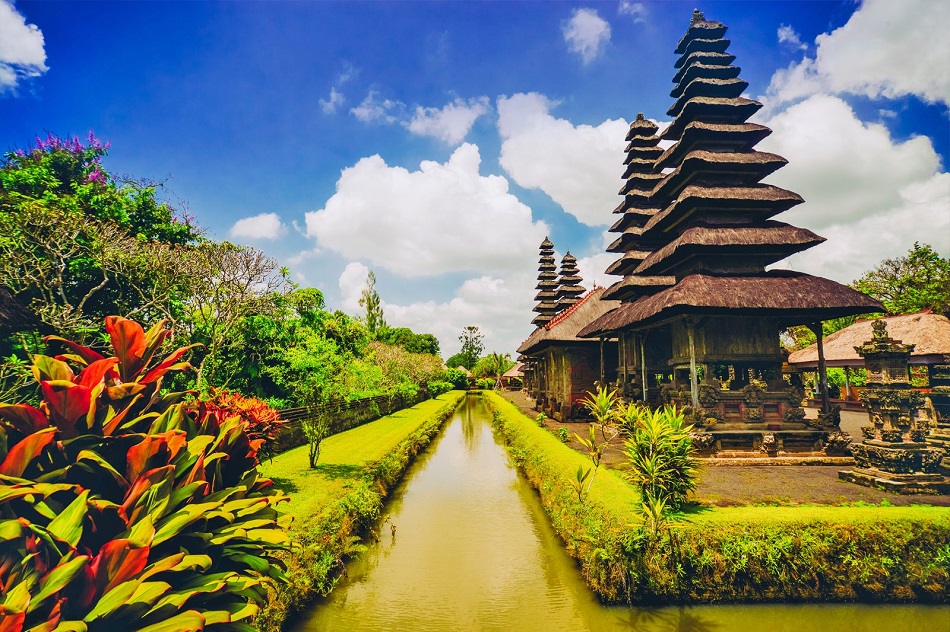
History of Taman Ayun
Built in the 17th century by the king of Mengwi, Taman Ayun is steeped in history. The garden, with its expansive fish ponds and meticulously manicured lawns, was designed as a manifestation of the mythical Mount Meru, the centre of the universe in Hindu cosmology. This blend of historical and spiritual significance adds an additional layer of fascination to your visit.
Floral Diversity at Taman Ayun
As you wander through Taman Ayun, you're greeted by an impressive array of plant species. From towering palm trees to delicate orchids, the garden's biodiversity is a visual delight. One of the highlights is the 'Bunga Kertas' (Bougainvillea), a vibrant climber that drapes the garden's ancient stone statues in a riot of colour.
The garden's tranquil setting and its stunning floral display make Taman Ayun a must-visit for nature enthusiasts and history buffs alike.
Ubud Botanic Garden: A Tropical Paradise
Tucked away in the artistic hub of Ubud, the Ubud Botanic Garden is a tropical paradise that houses a vast collection of native and exotic plant species. Designed by a team of passionate botanists and landscape architects, the garden is a haven for plant lovers and a sanctuary for those seeking respite from the bustling town.
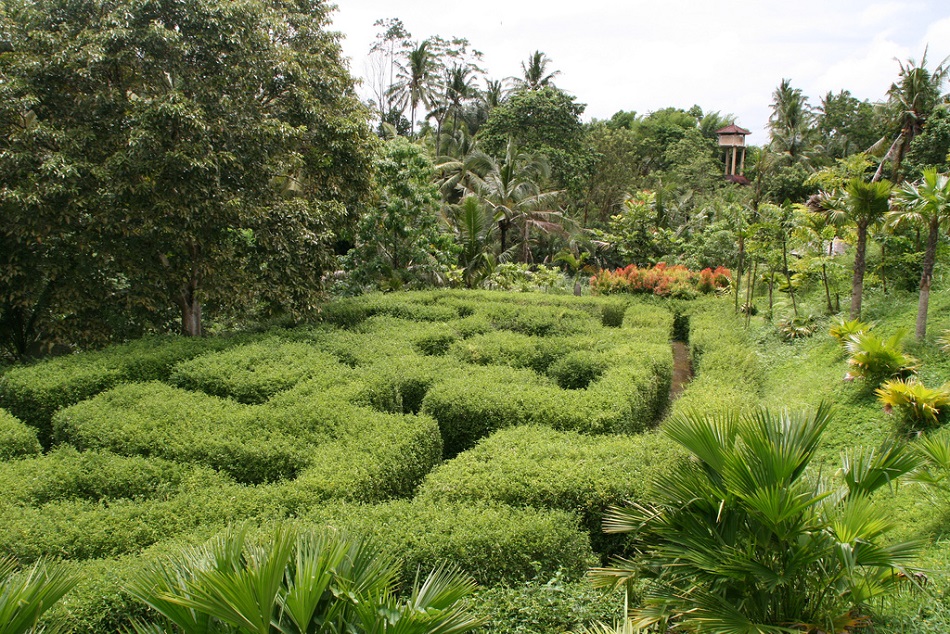
Unique Plant Species in Ubud Botanic Garden
The Ubud Botanic Garden's vast collection includes some of the island's most unique plant species. From the exotic 'Bunga Bangkai' (Corpse Flower), known for its pungent odour, to the enchanting 'Bunga Anggrek Bulan' (Moon Orchid), one of Indonesia's national flowers, the garden is a treasure trove of botanical wonders.
Garden Design and Landscape Architecture
The garden's design is a testament to the ingenuity of its creators. With its meandering pathways, stunning water features, and various themed sections, including a fern garden, a palm garden, and a medicinal plant garden, the Ubud Botanic Garden offers a diverse and immersive botanical experience. The 'Buss' arrangement, a lush assembly of native ferns and palms, is a popular choice among visitors wanting to bring a piece of this tropical paradise home.
Continuing on our floral journey, we make our way to the Bali Orchid Garden and the Taman Ujung Water Palace, two more of the island's floral gems that promise to captivate with their beauty and charm.
Section II: Bali's Iconic Flower Markets
From the hustle and bustle of Pasar Kumbasari to the cultural vibrancy of Pasar Badung, Bali's flower markets are a sensory delight. They offer a glimpse into the daily life of the locals and the significant role that flowers play in their culture.
Pasar Kumbasari: The Heart of Denpasar
Pasar Kumbasari, located in Bali's bustling capital city, Denpasar, is a vibrant hub of floral activity. As the sun rises, the market comes alive with locals and tourists alike, eager to explore its myriad of offerings.
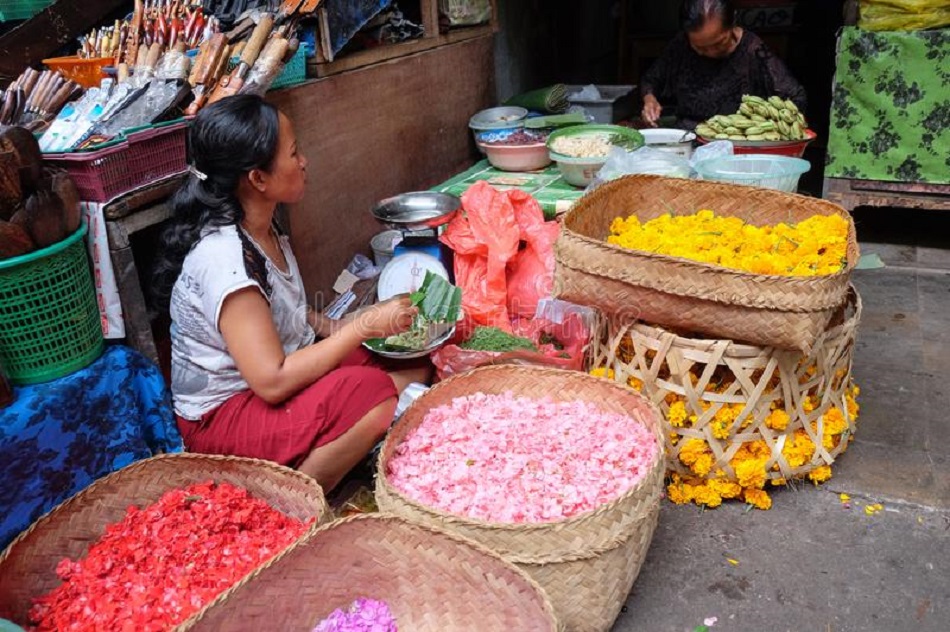
Exploring Pasar Kumbasari
Upon entering Pasar Kumbasari, your senses will be greeted with a riot of colours, fragrances, and the infectious energy of the market traders. Stall after stall, you'll find an array of exotic flowers, from the delicate Jasmine to the vibrant Marigold, and the beloved Lotus - a significant symbol in Balinese Hinduism.
The Most Popular Flowers at Pasar Kumbasari
Of the many floral varieties available, the 'Bunga Jepun' (Frangipani) stands out. Revered for its sweet scent and elegance, it's a quintessential part of Balinese culture, often seen in temples and used in religious ceremonies. The market also offers a vast array of floral arrangements, such as 'Alesha', perfect for bringing a touch of Balinese charm into your home.
Pasar Badung: A Cultural Experience
Next on our floral tour is Pasar Badung, the largest traditional market in Bali. More than just a marketplace, Pasar Badung offers an authentic cultural experience, providing insights into the island's traditional ways of life.
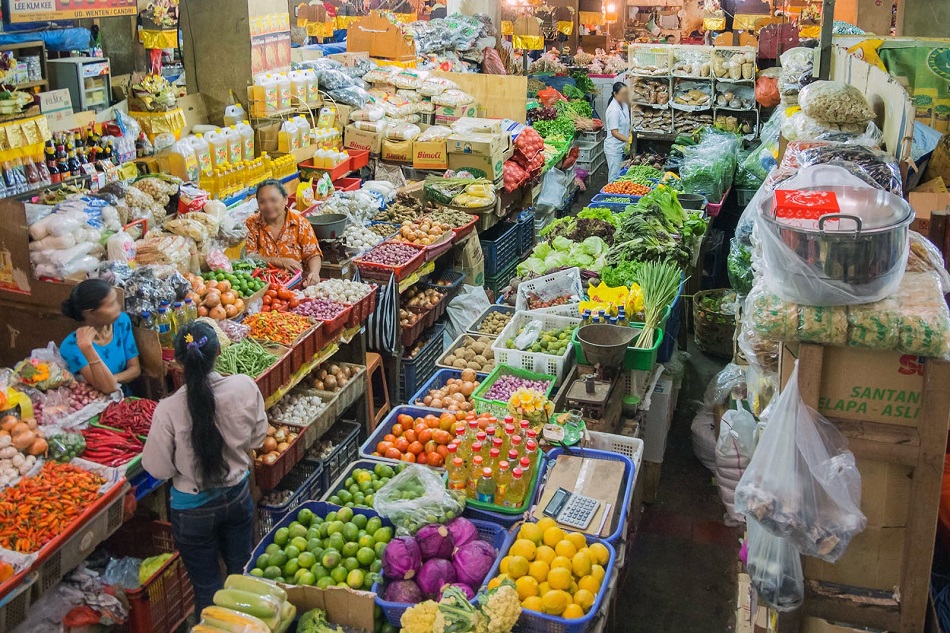
Navigating Pasar Badung
Navigating the labyrinthine alleys of Pasar Badung is an adventure in itself. As you wander through the market , the aromatic scent of marigolds, gardenias, and frangipanis waft through the air, leading you towards the flower sellers. Here, you'll find an astonishing variety of fresh blooms, ornamental plants, and intricately crafted floral offerings known as 'canang sari'.
Traditional Uses of Flowers in Balinese Culture
In Balinese culture, flowers are not merely decorative items. They hold deep symbolic meanings and play a vital role in religious rituals and ceremonies. For example, the vibrant 'Bunga Soka' (Ixora) is often used in temple offerings and ceremonies due to its vibrant red colour, symbolising the power of the Hindu God of creation, Brahma.
Pasar Sindu: The Local's Favourite
Tucked away in the heart of Sanur, Pasar Sindu is a favourite among locals. Less crowded than its counterparts in Denpasar, this market offers a more relaxed shopping experience, making it a perfect spot for those who prefer a slower pace.
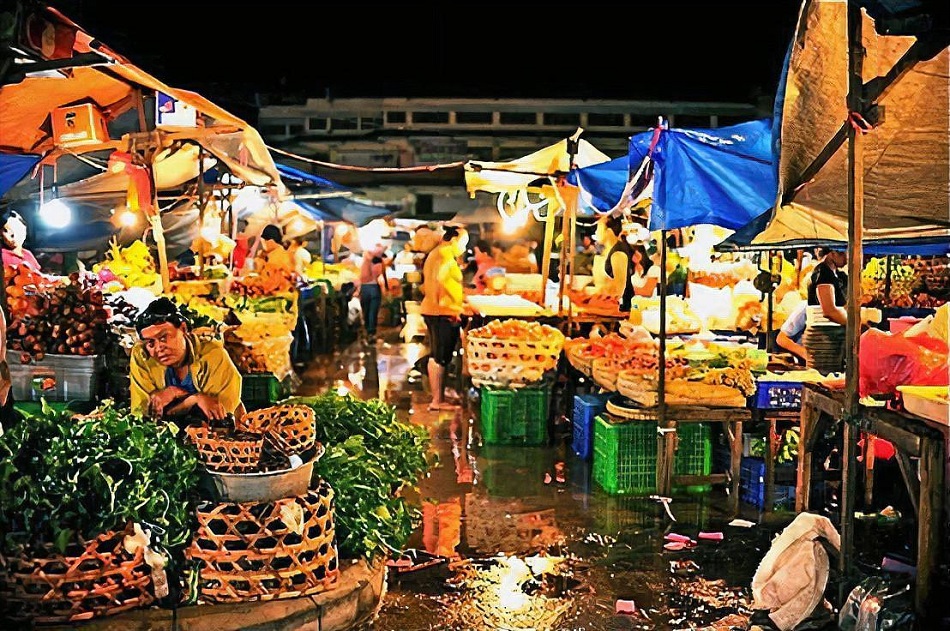
A Walkthrough of Pasar Sindu
As you stroll through Pasar Sindu, you will notice the harmonious blend of traditional and modern influences. From the timeless charm of marigolds and lotuses to the contemporary allure of the 'Mia' and 'Farah' arrangements, there's something to satisfy every floral aficionado.
How Locals Use Flowers in Everyday Life
Flowers in Bali are more than just a feast for the eyes. They are woven into the fabric of daily life, serving as tokens of gratitude, symbols of love, and offerings to the Gods. For example, the vibrant 'Bunga Kamboja' (Frangipani) is often seen adorning the hair of Balinese women as a symbol of beauty and purity.
Section III: The Significance of Flowers in Balinese Culture
Flowers, in Bali, are more than just a feast for the eyes; they hold profound significance in the island's cultural, religious, and aesthetic traditions. They serve as sacred offerings, inspire art and dance, and play a central role in local folklore and mythology.
Flowers in Balinese Rituals and Ceremonies
In Balinese Hindu rituals and ceremonies, flowers are integral. Each offering, or 'canang sari', is a small square basket made of palm leaf filled with an assortment of flowers, each colour symbolising a Balinese Hindu God. White flowers, pointed towards the mountains, symbolise Iswara, the god associated with the east. Red flowers, pointed to the south, represent Brahma, while yellow flowers symbolising Mahadeva are directed to the west. Lastly, blue or green flowers for Vishnu are oriented towards the north.
Among these, the frangipani (plumeria) is commonly used, its robust petals and lasting fragrance making it an ideal offering flower. Also, the 'Bunga Jepun' or 'Bunga Kamboja' as it is locally known, is a beloved flower in Bali, often seen in temple offerings or used in hair for traditional dances. The beauty of these fragrant blooms has been captured in the 'Asha' bouquet, a popular choice for those wanting to bring the sacred aura of Balinese rituals into their homes.
The Role of Flowers in Balinese Art and Aesthetics
Flowers also play a prominent role in Balinese art and aesthetics. The island's art, whether it's painting, carving, textile design or dance, is characterised by intricate floral motifs. The 'Bunga Cempaka', with its delicate petals and sweet fragrance, is a common motif, symbolising purity and eternal love. In traditional Balinese dance, performers often wear elaborate floral headdresses and garlands, enhancing the visual spectacle of the performance.
Flowers as Symbols in Balinese Folklore and Mythology
In Balinese folklore and mythology, flowers often serve as powerful symbols. The 'Bunga Padma', or Lotus flower, for example, is a symbol of enlightenment and divine beauty. It is often associated with the goddess of knowledge and art, Saraswati, and is frequently depicted in Balinese paintings and carvings. The 'Alesha' arrangement, featuring a stunning lotus display, is a beautiful representation of this sacred symbolism.
The significance of flowers in Balinese culture is a testament to the island's profound respect for nature and its deep spiritual beliefs. As we conclude our floral tour of Bali, we invite you to reflect on the floral wonders of the island and the many ways they enhance and enrich the Balinese way of life.
Summing Up...
A tour of the idyllic island of Bali through the lens of its vibrant floral landscapes offers a deeply enriching journey that transcends the sensory experience. It unearths the profound interconnectedness of nature, culture, and spirituality that is woven into the very fabric of Balinese life. Each garden visited and every market explored has unfurled a unique narrative, shedding light on the island's rich history, biodiversity, and enduring cultural traditions.
From the royal gardens of Taman Ayun, where the scent of frangipani blooms blend seamlessly with the whispers of history, to the verdant expanses of Ubud Botanic Garden, a refuge for both endemic and global plant species, the journey has been a sensory delight. The resplendent orchids at Bali Orchid Garden, the historical and floral marvels of Taman Ujung Water Palace, and the conservation efforts at the Bali Zoo further enriched the narrative, adding layers of context and meaning.
The bustling flower markets of Bali, with their riotous colours and enchanting fragrances, have provided an immersive cultural experience. The lively chaos of Pasar Kumbasari, the cultural insights at Pasar Badung, the local charm of Pasar Sindu, and the unique highland flowers of Candi Kuning Market have all offered glimpses into the everyday lives of the Balinese people and their intimate relationship with flowers.
Beyond their aesthetic appeal, the flowers of Bali hold deep cultural and spiritual significance. They are not merely adornments but powerful symbols, integral to religious rituals, artistic expressions, and local folklore. Their omnipresence in Balinese life underscores the islanders' profound respect for nature and their harmonious coexistence with their environment.
As we draw this floral journey to a close, it's clear that Bali's floral landscapes are more than just a visual spectacle. They are living, breathing narratives that tell the story of the island and its people, a testament to Bali's rich biodiversity, and a poignant reminder of the delicate balance between man and nature.
In the enchanting world of Bali's gardens and flower markets, each blossom has a story to tell, each petal a secret to share. And so, the next time you find yourself in Bali, we invite you to embark on your own floral journey, to explore the island's floral wonders, and in doing so, discover the essence of Bali.
Whether it be the regal charm of the 'Marley' arrangement or the traditional elegance of the 'Ayu', each bouquet from Lily's Florist Bali captures a piece of Bali's unique floral heritage, allowing you to bring a piece of this paradise into your home.
In the end, the floral tour of Bali is not just about appreciating the beauty of the flowers; it's about understanding their role in the grand scheme of things - in the balance of nature, in the culture of the people, and in the beauty of life itself.
